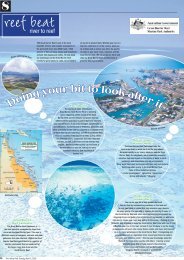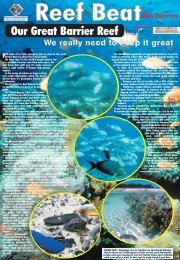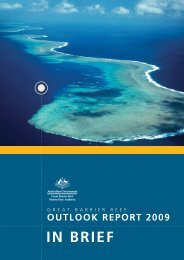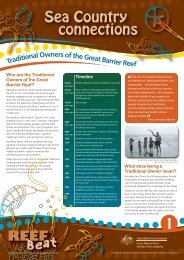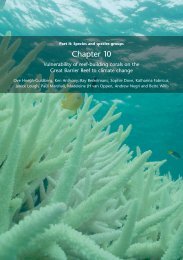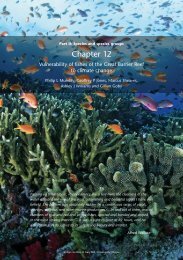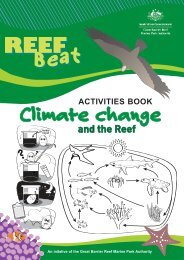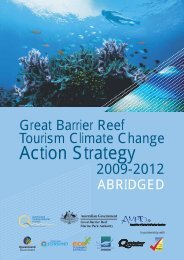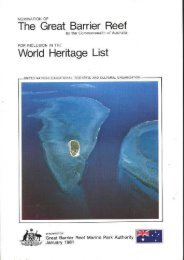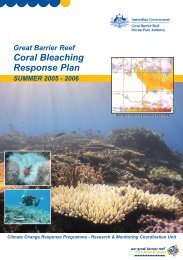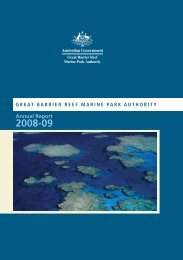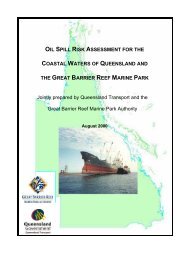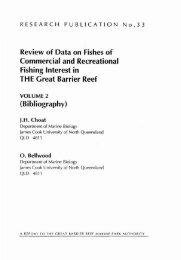Chapter 1: Introduction to the Great Barrier Reef and climate change
Chapter 1: Introduction to the Great Barrier Reef and climate change
Chapter 1: Introduction to the Great Barrier Reef and climate change
Create successful ePaper yourself
Turn your PDF publications into a flip-book with our unique Google optimized e-Paper software.
1.2.2 The physical environment<br />
The <strong>Great</strong> <strong>Barrier</strong> <strong>Reef</strong> extends along approximately 14 degrees of latitude, with marine realms<br />
spanning coastal <strong>to</strong> oceanic. This geographic diversity encompasses a range of physical conditions,<br />
including various regimes of temperature, current influence, water quality <strong>and</strong> wea<strong>the</strong>r.<br />
The <strong>climate</strong> of <strong>the</strong> <strong>Great</strong> <strong>Barrier</strong> <strong>Reef</strong> is influenced by monsoonal wind <strong>and</strong> rainfall patterns. Strong<br />
south-easterly winds dominate during <strong>the</strong> dry season (April <strong>to</strong> Oc<strong>to</strong>ber), while weaker variable winds<br />
are more common during <strong>the</strong> summer wet season when most of <strong>the</strong> annual rainfall occurs. Mean<br />
sea temperatures in offshore waters vary between 23°C in <strong>the</strong> coldest months of <strong>the</strong> dry season (July<br />
<strong>to</strong> August) <strong>and</strong> 28°C in <strong>the</strong> warmest months of <strong>the</strong> wet season (January <strong>to</strong> February). Inshore areas<br />
generally experience a higher seasonal range of between 21 <strong>and</strong> 30°C. Cyclones are most likely <strong>to</strong><br />
occur between January <strong>and</strong> April. The high winds at <strong>the</strong> centre of a cyclone create large, powerful<br />
waves that can greatly affect coral reefs <strong>and</strong> o<strong>the</strong>r marine habitats. Any single cyclone only affects a<br />
small proportion of <strong>the</strong> area of <strong>the</strong> <strong>Great</strong> <strong>Barrier</strong> <strong>Reef</strong>, but over many decades, almost every part of<br />
<strong>the</strong> <strong>Great</strong> <strong>Barrier</strong> <strong>Reef</strong> will be affected by a cyclone at least once.<br />
Currents are important physical driving fac<strong>to</strong>rs that strongly affect <strong>the</strong> <strong>Great</strong> <strong>Barrier</strong> <strong>Reef</strong>’s biodiversity<br />
<strong>and</strong> its ecosystem functions. There are three types of current: oceanic, wind-driven <strong>and</strong> tidal. All three<br />
interact in complex ways with <strong>the</strong> physical structure of <strong>the</strong> <strong>Great</strong> <strong>Barrier</strong> <strong>Reef</strong>’s seabed <strong>to</strong> produce <strong>the</strong><br />
current regime. The South Equa<strong>to</strong>rial Current is an oceanic current that flows westward across <strong>the</strong><br />
Pacific Ocean <strong>and</strong> Coral Sea. When it reaches <strong>the</strong> Australian continental shelf at about 14 degrees<br />
south, it divides in<strong>to</strong> two currents. One of <strong>the</strong>se flows north along <strong>the</strong> edge of <strong>the</strong> continental shelf,<br />
<strong>the</strong> Hiri Current, <strong>and</strong> <strong>the</strong> o<strong>the</strong>r flows south, <strong>the</strong> East Australian Current.<br />
At a regional scale, <strong>the</strong>se three currents are <strong>the</strong> most significant currents that influence <strong>the</strong><br />
oceanography of <strong>the</strong> <strong>Great</strong> <strong>Barrier</strong> <strong>Reef</strong>. In some areas, <strong>the</strong>se shelf-edge currents can cause upwelling<br />
of deep, cold, nutrient-rich water on<strong>to</strong> <strong>the</strong> continental shelf. This upwelled water has regional effects<br />
on biodiversity <strong>and</strong> can cause <strong>the</strong> formation of significant habitats, such as large algal mounds,<br />
only found in <strong>the</strong> far nor<strong>the</strong>rn <strong>Great</strong> <strong>Barrier</strong> <strong>Reef</strong>. While oceanic currents have a strong influence on<br />
currents on <strong>the</strong> continental shelf, in shallow waters, currents are also driven by wind. In strong wind<br />
conditions, particularly those during <strong>the</strong> dry season with steady south-easterly winds, <strong>the</strong> effect of<br />
wind on current direction can be stronger than that of oceanic currents. Oceanic <strong>and</strong> wind-driven<br />
currents primarily drive water parallel <strong>to</strong> <strong>the</strong> coast, along <strong>the</strong> continental shelf. However, <strong>the</strong> tides,<br />
which operate on a 12-hour cycle, drive water across <strong>the</strong> continental shelf perpendicular <strong>to</strong> <strong>the</strong> coast.<br />
These two driving forces for currents, operating at 90 degrees <strong>to</strong> each o<strong>the</strong>r, create a complex pattern<br />
of water movement, especially in <strong>and</strong> around <strong>the</strong> intricate matrix of <strong>the</strong> coral reefs.<br />
Part I: <strong>Introduction</strong><br />
<strong>Chapter</strong> 1: <strong>Introduction</strong> <strong>to</strong> <strong>the</strong> <strong>Great</strong> <strong>Barrier</strong> <strong>Reef</strong> <strong>and</strong> <strong>climate</strong> <strong>change</strong><br />
1.2.3 The human dimensions<br />
The <strong>Great</strong> <strong>Barrier</strong> <strong>Reef</strong> is iconic. It has a central place in Australian culture <strong>and</strong> psyche, <strong>and</strong> a visit <strong>to</strong><br />
<strong>the</strong> reef is reliably rated among <strong>the</strong> <strong>to</strong>p three must do experiences in international surveys. The <strong>Great</strong><br />
<strong>Barrier</strong> <strong>Reef</strong> has continued <strong>to</strong> evoke wonder <strong>and</strong> awe in visi<strong>to</strong>rs, from <strong>the</strong> earliest European explorers<br />
negotiating <strong>the</strong> “monstrous labyrinth of coral” by sailing ship, <strong>to</strong> <strong>the</strong> thous<strong>and</strong>s of <strong>to</strong>urists who arrive<br />
annually <strong>to</strong> experience one of <strong>the</strong> natural wonders of <strong>the</strong> world. Long before <strong>the</strong>se relatively recent<br />
visi<strong>to</strong>rs, however, it was Indigenous Australians who had established a strong relationship with <strong>the</strong><br />
<strong>Great</strong> <strong>Barrier</strong> <strong>Reef</strong>.<br />
Climate Change <strong>and</strong> <strong>the</strong> <strong>Great</strong> <strong>Barrier</strong> <strong>Reef</strong>: A Vulnerability Assessment



